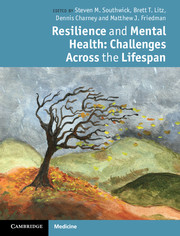Book contents
- Frontmatter
- Contents
- Contributors
- Preface
- Section 1 Pathways to resilience
- Section 2 Resilience across the lifespan
- Section 3 Resilience in families, communities, and societies
- Section 4 Specific challenges
- 13 Loss and grief: the role of individual differences
- 14 Reorienting resilience: adapting resilience for post-disaster research
- 15 Rape and other sexual assault
- 16 The stress continuum model: a military organizational approach to resilience and recovery
- 17 Resilience in the face of terrorism: linking resource investment with engagement
- 18 Resilience in the context of poverty
- 19 Resiliency in individuals with serious mental illness
- Section 5 Training for resilience
- Index
- References
13 - Loss and grief: the role of individual differences
from Section 4 - Specific challenges
Published online by Cambridge University Press: 07 September 2011
- Frontmatter
- Contents
- Contributors
- Preface
- Section 1 Pathways to resilience
- Section 2 Resilience across the lifespan
- Section 3 Resilience in families, communities, and societies
- Section 4 Specific challenges
- 13 Loss and grief: the role of individual differences
- 14 Reorienting resilience: adapting resilience for post-disaster research
- 15 Rape and other sexual assault
- 16 The stress continuum model: a military organizational approach to resilience and recovery
- 17 Resilience in the face of terrorism: linking resource investment with engagement
- 18 Resilience in the context of poverty
- 19 Resiliency in individuals with serious mental illness
- Section 5 Training for resilience
- Index
- References
Summary
Introduction
It is an unfortunate but inevitable fact of life that virtually all of us must face: people we are close to die. Despite this universality, researchers and theorists have long assumed that bereavement almost always results in significant, and sometimes incapacitating, distress. Curiously, the absence of distress after loss has itself been considered pathological and a likely harbinger of future difficulties (Middleton et al., 1993). When bereaved persons fail to display the expected distress reaction, some have maintained that they are suppressing their grief (Middleton et al., 1993) or lack an attachment to their spouse (Fraley & Shaver, 1999). Indeed, emotional expression following loss – particularly negative emotions – has long been considered cathartic, a necessary ingredient of healthy adjustment (Freud, 1957). Perhaps for this reason, bereaved people who appear outwardly resilient and who resume their lives with minimal disruptions have often been thought to possess extraordinary coping abilities.
However, this idea has increasingly come under fire (Bonanno, 2004). In fact, most bereaved people experience relatively transient disruptions in their ability to function effectively. Furthermore, research increasingly shows that there is a marked diversity in how people respond to loss. Indeed, it appears that three primary patterns or trajectories adequately describe most people’s response to interpersonal loss. The largest category, usually from 50% to 60%, is characterized by stable, healthy levels of psychological and physical functioning relatively soon after a loss, or “resilience” (Bonanno, 2004; Mancini & Bonanno, 2006). A second category of bereaved persons (20–25%) displays more acute and persistent levels of distress but gradually they too recover their bearings and return to their former level of functioning. The most problematic reaction is found among those with a persistent syndrome of a sometimes incapacitating distress that may take years to resolve. This pattern, often described as “complicated grief” (Bonanno et al., 2007), is relatively rare, typically occurring in 10–15% of grievers (Bonanno & Kaltman, 2001). Two other types of bereavement response have also emerged recently, although they typically characterize only a small proportion of grievers. These include a chronic form of distress that predated the loss and is exacerbated in its aftermath (Bonanno et al., 2002; Mancini et al., 2011) and dramatic improvement following loss (A.D. Mancini, I. Galatzer-Levy, & G.A. Bonanno, unpublished data). Although each is quite uncommon (5–10%), these patterns have been confirmed using different methods and samples, suggesting that they are veridical.
- Type
- Chapter
- Information
- Resilience and Mental HealthChallenges Across the Lifespan, pp. 189 - 199Publisher: Cambridge University PressPrint publication year: 2011
References
- 5
- Cited by

